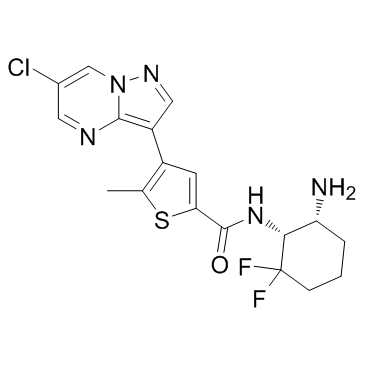| Description |
MARK-IN-2 is a potent microtubule affinity regulating kinase (MARK) inhibitor with an IC50 of 5 nM.
|
| Related Catalog |
|
| Target |
IC50: 5 nM (MARK)[1]
|
| In Vitro |
MARK-IN-2 (Compound 27) is a potent MARK inhibitor. Inhibition of MARK represents a potentially attractive means of arresting neurofibrillary tangle pathology in Alzheimer's disease. MARK-IN-2 inhibits MARK3 with an IC50 of 5 nM. MARK-IN-2 also inhibits MARK3 in primary cell culture of rat cortical neurons with an IC50 of 280 nM[1].
|
| In Vivo |
Characterization of the i.v. pharmacokinetic properties of MARK-IN-2 in rat and dog reveals reasonable volumes of distribution but moderate to high clearance and short half-lives. MARK-IN-2 (Compound 27) has moderate terminal elimination half-life (t1/2=0.7 h, and 1 h for rat and dog) [1].
|
| Cell Assay |
The cell biochemical potency of the below described MARK inhibitors (e.g., MARK-IN-2) is evaluated by measuring their ability to block the phosphorylation of Tau at S262 in primary cell culture of rat cortical neurons induced by the action of Okadaic acid[1].
|
| Animal Admin |
Rats[1] Male Sprague-Dawley Rats are via a previously implanted venous catheter at 1 mL/kg and by gastric gavage at 5 mL/kg. Male Beagle Dogs are dosed via a saphenous vein indwelling catheter at 0.5 mL/kg and by gastric gavage at 5 mL/kg. Blood samples are collected into tubes containing EDTA at pre-dose and at 5 (intravenously administered drugs only), 15, and 30 min and 1, 2, 4, 6, 8, 12, and 24 h after drug administration. After sampling, whole blood is centrifuged at 14,000 rpm for 5 min, and plasma was stored frozen at -20ºC until the day of analysis[1].
|
| References |
[1]. Sloman DL, et al. Optimization of microtubule affinity regulating kinase (MARK) inhibitors with improved physical properties. Bioorg Med Chem Lett. 2016 Sep 1;26(17):4362-6.
|
